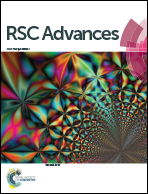Improvement of self-cleaning waterborne polyurethane-acrylate with cationic TiO2/reduced graphene oxide†
Abstract
UV curable waterborne polyurethane acrylate (WPUA) with surfactant-modified TiO2/reduced graphene oxide (TiO2/rGO) nanocomposites were prepared and analyzed to improve their mechanical performance and self-cleaning ability. TiO2/rGO nanocomposites were prepared by a simple hydrothermal method with nano-TiO2 and graphene oxide, and modified with cationic surfactant (CTAB) to obtain a cationic TiO2/rGO (C-TiO2/rGO). Then, the obtained C-TiO2/rGO was incorporated into anionic waterborne polyurethane acrylate by in situ fabrication to obtain a composite emulsion (C-TiO2/rGO-WPUA). The results of Fourier transform infrared spectroscopy (FTIR), X-ray diffraction (XRD), and scanning electron microscopy (SEM) showed that CTAB was successfully intercalated into TiO2/rGO, and TiO2 nanoparticles were evenly distributed on graphene sheets with good dispersibility. Compared to UV-cured neat WPUA and C-TiO2/rGO-WPUA, the mechanical properties and thermal stability of the composites were significantly improved. When the content of C-TiO2/rGO was 0.5%, the UV-cured composites had overall excellent performance. In particular, the WPUA composites exhibited good self-cleaning ability in photocatalysis. The photocatalytic degradation rate of methyl orange in 0.5% C-TiO2/rGO-WPUA reached 88.3% under 6 h visible light irradiation.



 Please wait while we load your content...
Please wait while we load your content...